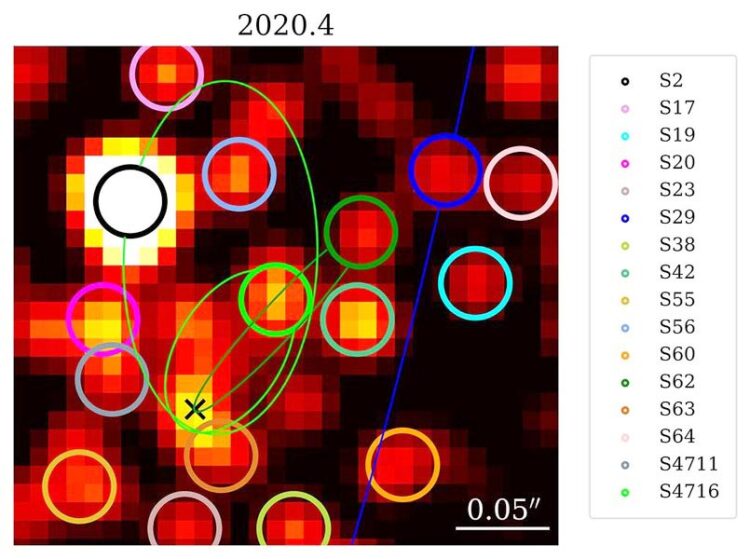8000 kilometres per second

Observation of S4716 in 2020 with OSIRIS.
Star with the shortest orbital period around black hole discovered.
A newly discovered star only takes four years to travel around the black hole at the centre of our galaxy / publication in ‘The Astrophysical Journal’.
Researchers at the University of Cologne and Masaryk University in Brno (Czech Republic) have discovered the fastest known star, which travels around a black hole in record time. The star, S4716, orbits Sagittarius A*, the black hole in the centre of our Milky Way, in four years and reaches a speed of around 8000 kilometres per second. S4716 comes as close as 100 AU (astronomical unit) to the black hole – a small distance by astronomical standards. One AU corresponds to 149,597,870 kilometres. The study has been published in The Astrophysical Journal.
In the vicinity of the black hole at the centre of our galaxy is a densely packed cluster of stars. This cluster, called S cluster, is home to well over a hundred stars that differ in their brightness and mass. S stars move particularly fast. ‘One prominent member, S2, behaves like a large person sitting in front of you in a movie theatre: it blocks your view of what’s important,’ said Dr Florian Peissker, lead author of the new study. ‘The view into the centre of our galaxy is therefore often obscured by S2. However, in brief moments we can observe the surroundings of the central black hole.’
By means of continuously refining methods of analysis, together with observations covering almost twenty years, the scientist now identified without a doubt a star that travels around the central supermassive black hole in just four years. A total of five telescopes observed the star, with four of these five being combined into one large telescope to allow even more accurate and detailed observations. ‘For a star to be in a stable orbit so close and fast in the vicinity of a supermassive black hole was completely unexpected and marks the limit that can be observed with traditional telescopes,’ said Peissker.
Moreover, the discovery sheds new light on the origin and evolution of the orbit of fast-moving stars in the heart of the Milky Way. ‘The short-period, compact orbit of S4716 is quite puzzling,’ Michael Zajaček, an astrophysicist at Masaryk University in Brno who was involved in the study, said. ‘Stars cannot form so easily near the black hole. S4716 had to move inwards, for example by approaching other stars and objects in the S cluster, which caused its orbit to shrink significantly,’ he added.
Media Contact:
Dr Florian Peissker
Institute of Astrophysics (previously I. Physics Institute)
+49 221 470 3491
peissker@ph1.uni-koeln.de
Press and Communications Team:
Jan Voelkel
+49 221 470 2356
j.voelkel@verw.uni-koeln.de
Publication:
https://doi.org/10.3847/1538-4357/ac752f
Media Contact
All latest news from the category: Physics and Astronomy
This area deals with the fundamental laws and building blocks of nature and how they interact, the properties and the behavior of matter, and research into space and time and their structures.
innovations-report provides in-depth reports and articles on subjects such as astrophysics, laser technologies, nuclear, quantum, particle and solid-state physics, nanotechnologies, planetary research and findings (Mars, Venus) and developments related to the Hubble Telescope.
Newest articles

NASA: Mystery of life’s handedness deepens
The mystery of why life uses molecules with specific orientations has deepened with a NASA-funded discovery that RNA — a key molecule thought to have potentially held the instructions for…

What are the effects of historic lithium mining on water quality?
Study reveals low levels of common contaminants but high levels of other elements in waters associated with an abandoned lithium mine. Lithium ore and mining waste from a historic lithium…

Quantum-inspired design boosts efficiency of heat-to-electricity conversion
Rice engineers take unconventional route to improving thermophotovoltaic systems. Researchers at Rice University have found a new way to improve a key element of thermophotovoltaic (TPV) systems, which convert heat…



